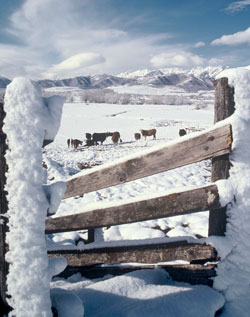Fall and winter grazing helps range plants by allowing them to rest during the growing season, and then be grazed while they are not trying to restock energy to leaves and roots. Livestock tend to graze more shrubs in the winter, so producers gain forage on shrubby rangelands, too. However, winter forage often will not provide enough nutrition for third-trimester and lactating cows. The solution, according to Mike Smith, a University of Wyoming researcher who received a SARE grant to study calving options, is to calve later in the year and avoid having third-trimester and lactating cows
in the winter.

Calving later in the spring allows cattle to maintain condition while grazing on winter grasses and forage. Photo by Ron Daines
“Late-season calving in most of the West saves anywhere from a few pounds of hay every day if snow covers the ground to the ability to switch to a completely forage-based operation because the cattle have lower nutritional demands and can maintain their condition with dormant grasses,” Smith says. “Later calving also means less labor during calving because most cows can calve alone in warm weather.”
Smith found that combined hay and labor savings lowered the break-even price to 50 cents a pound on 500-pound, May-calved and fall-weaned calves. That price, he emphasized, was an example from just one ranch in a given year.
“Lower break-evens do better in good times and (help producers) stay in the game in bad times,” he says.
Smith used his SARE-funded research to demonstrate the benefits of matching a cow’s highest nutritional needs with the best nutrition offered from forage to Wyoming ranchers Kelley O’Neill and Mike Crimmins. Keeping their eyes on that prize helped O’Neill and Crimmins overcome several obstacles and switch their herd to late-season calving.
O’Neill, a shareholder in the Kelley Land and Cattle Co. of Wyoming (KLCC-WY) and Crimmins, ranch manager for 50,000 acres of private and public KLCC-WY land south of Saratoga, moved their calving season from February and March to May and June in 1994. They still wean during October and November and they retain the calves in a feedlot so they can capture the highest seasonal fed cattle market the next March and April.
Later calving meant adjusting their grazing on other public lands, too. The May-born calves could not travel the 25 miles to KLCC-WY’s summer grazing permit at just one month old. So O’Neill and Crimmins now move their late-gestation cows to BLM lands in May, prior to calving, if each cow has calved for three years without difficulties.
In California, annual grasses grow while it rains from November through April. At the University of California Sierra Foothill Research and Extension Center, a demonstration ranch partly funded by SARE uses the same principle of matching forage to nutritional needs to calve from early April through mid-May instead of following the traditional fall-calving schedule. Annual grasses lose their nutritional quality quickly – from 20 percent protein in March down to about 6 percent in August and 4 percent in the fall – so California ranchers who schedule fall calving are challenged to maintain cattle body condition.
By changing from fall calving to a combination of spring calving, summer breeding and late-summer weaning, SARE project participants actually increased the cows’ body condition score prior to breeding instead of watching it deteriorate despite feeding bales, blocks and bags of protein cubes. Spring calves were 60 pounds lighter than their fall counterparts, but ranchers lowered their costs by not feeding a lot of hay to the spring-calving cows. The spring calves caught up to the fall calves by 11 months of age, suggesting that retained ownership after weaning might be the most profitable strategy to manage this enterprise.
“A challenge is how to manage cash flow if you are switching a fall-calving herd to spring calving since you will produce no income from the cows for a year,” says Roger Ingram, a farm adviser for Placer and Nevada counties in Auburn, Calif., who led the SARE project. Solutions to this temporary financial dilemma include switching half of the cattle herd at a time so the herd generates at least some income each year, and careful planning and budgeting.
Participants in Ingram’s California Grazing Academy, held at the research site, realized higher cattle prices and better-growing grass, thanks to more intensive grazing management. Participants used a high stocking density and short grazing periods on both rangeland and irrigated pastures. After two years, they increased grazing days by 64 percent while maintaining the same residual matter in each pasture.
“We generally managed for 90 days of rest during slow growth – from mid-May through February – and 30 days of rest during fast growth from March through mid May,” says Ingram. “If we had slow growth in March due to lack of rain, we stayed with our 90 days of rest until fast growth finally occurred.”
Every May, they took a paddock walk to determine the number of grazing days remaining before the next rains, and growth would start again in November.
Another potential benefit of calving with the grass is that late-calving cows are usually cheaper to buy than February- and March-calving cows. Instead of retaining heifers, Troy Stafford, a rancher from Riverton, Wyo., buys his neighbors’ late-calvers, usually for a little over slaughter price.
“Frequently, these cows breed late because they produce too much milk, resulting in delayed cycling,” Stafford says. “Cows and heifers are often culled because they are too good as mothers.”
In the end, it all comes back to establishing goals and designing strategies to meet those goals.t
“Sustainable ranching is not just later calving, but a change in mindset from the past, a paradigm shift,” says Wyoming’s Mike Smith.
To learn more, visit:
- https://ucanr.edu/sites/Livestock/Grazing/ for the California grazing academy and more
- https://extension.usu.edu/rangelands/ou-files/USDA-Kochia.pdf to find out more about forage kochia
- www.uwyo.edu/ces/PUBS/B-1076.htm to learn the details about the KLCC-WY Co
